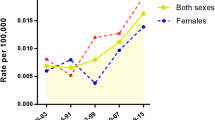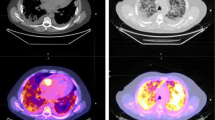Abstract
Background
Cardiac sarcomas are rare and aggressive tumors with little known about the demographics, genetics, or treatment outcomes.
Objectives
The objectives of this study were to characterize the demographics, treatment modality, and survival associated with cardiac sarcomas and evaluate the potential for mutation-directed therapies.
Methods
All cases from 2000 to 2018 of cardiac sarcoma were extracted from the SEER database. Genomic comparison utilized The Cancer Genome Atlas (TCGA) database, as well as reviews and re-analysis of past applicable genomic studies.
Results
Cardiac sarcomas occurred most often in White patients, compared with national census data cardiac sarcomas occurred at a significantly higher rate in Asians. The majority of cases were undifferentiated (61.7%) and without distant metastases (71%). Surgery was the most common primary treatment modality and offered survival benefit (HR 0.391 (p = 0.001) that was most pronounced and sustained as compared to patients who received chemotherapy (HR 0.423 (p = 0.001) or radiation (HR 0.826 (p = 0.241) monotherapy. There was no difference in survival when stratified by race or sex; however, younger patients (< 50) had better survival. Genomics data on histologically undifferentiated cardiac sarcomas revealed a significant number were likely poorly differentiated pulmonary intimal sarcomas and angiosarcomas.
Conclusions
Cardiac sarcoma is a rare disease with surgery continuing to be a cornerstone of therapy followed by traditional chemotherapy. Case studies have indicated the potential for therapies directed to specific genetic aberrations to improve survival for these patients and utilization of next-generation sequencing (NGS) will help improve both classification and these therapies for cardiac sarcoma patients.
Graphical abstract






Similar content being viewed by others
Data availability
All the data is publicly available both from SEER and TCGA.
Abbreviations
- NGS:
-
Next-generation sequencing
- SEER:
-
Surveillance, epidemiology, and end results
- SAS:
-
Statistical analysis system
- PMCT:
-
Primary malignant cardiac tumors
- NCDB:
-
National Cancer Database
- NCCN:
-
National Comprehensive Cancer Network
- NRTK:
-
Neurotrophic receptor tyrosine kinase
- TCGA:
-
The Cancer Genome Atlas
References
Gupta R, Meghrajani V, Desai R, Gupta N (2020) Primary malignant cardiac tumors: a rare disease with an adventurous journey. J Am Heart Assoc 9(10):e016032. https://doi.org/10.1161/JAHA.120.016032
Urbini M, Astolfi A, Indio V et al (2020) Genetic aberrations and molecular biology of cardiac sarcoma. Ther Adv Med Oncol 12:1758835920918492. https://doi.org/10.1177/1758835920918492
Moeri-Schimmel R, Pras E, Desar I, Krol S, Braam P (2020) Primary sarcoma of the heart: case report and literature review. J Cardiothorac Surg 15(1):104. https://doi.org/10.1186/s13019-020-01157-4
Awad AK, Elgenidy A, Afifi AM, Sa MP, Ramlawi B (2022) Specific causes of death among patients with cardiac sarcoma in the United States—an analysis of The Surveillance, Epidemiology, and End Results (SEER) Program. J Card Surg 37(11):3961–3963. https://doi.org/10.1111/jocs.16857
Badge VS, Kohale M, Patil A, Revadekar A (2022) Spindle-cell sarcoma of the heart: a case report of a rare cause of cardiac mass. Ann Card Anaesth 25(2):220–224. https://doi.org/10.4103/aca.aca_242_20
Eqbal AJ, Goodliffe L, Masoom H et al (2022) The syncopal sarcoma: a rare case of primary cardiac synovial sarcoma. JACC Case Rep 4(16):1037–1041. https://doi.org/10.1016/j.jaccas.2022.07.010
Hasan SM, Witten J, Collier P et al (2021) Outcomes after resection of primary cardiac sarcoma. JTCVS Open 8:384–390. https://doi.org/10.1016/j.xjon.2021.08.038
Agaimy A, Rösch J, Weyand M, Strecker T (2012) Primary and metastatic cardiac sarcomas: a 12-year experience at a German heart center. Int J Clin Exp Pathol 5(9):928–938
Aloysius MM, Shrivastava S, Rojulpote C et al (2022) Racial and ethnic characteristics and cancer-specific survival in Primary Malignant Cardiac Tumors. Front Cardiovasc Med. 9:961160. https://doi.org/10.3389/fcvm.2022.961160
Qiu J, Sun Y, Wang S, Dong J, Zhu P (2021) Clinical characteristics and prognostic factors of primary malignant cardiac tumors. Chin Med J (Engl) 135(3):341–343. https://doi.org/10.1097/CM9.0000000000001623
Yu K, Liu Y, Wang H, Hu S, Long C (2007) Epidemiological and pathological characteristics of cardiac tumors: a clinical study of 242 cases. Interact Cardiovasc Thorac Surg 6(5):636–639. https://doi.org/10.1510/icvts.2007.156554
Sultan I, Bianco V, Habertheuer A et al (2020) Long-term outcomes of primary cardiac malignancies: multi-institutional results from the national cancer database. J Am Coll Cardiol 75(18):2338–2347. https://doi.org/10.1016/j.jacc.2020.03.041
Antwi-Amoabeng D, Meghji Z, Thakkar S et al (2020) Survival differences in men and women with primary malignant cardiac tumor: an analysis using the surveillance, epidemiology and end results (SEER) database from 1973 to 2015. J Am Heart Assoc 9(10):e014846. https://doi.org/10.1161/JAHA.119.014846
Li H, Xu D, Chen Z et al (2014) Prognostic analysis for survival after resections of localized primary cardiac sarcomas: a single-institution experience. Ann Thorac Surg 97(4):1379–1385. https://doi.org/10.1016/j.athoracsur.2013.12.030
Damerell V, Pepper MS, Prince S (2021) Molecular mechanisms underpinning sarcomas and implications for current and future therapy. Signal Transduct Target Ther 6(1):1–19. https://doi.org/10.1038/s41392-021-00647-8
Bui NQ, Przybyl J, Trabucco SE et al (2019) A clinico-genomic analysis of soft tissue sarcoma patients reveals CDKN2A deletion as a biomarker for poor prognosis. Clin Sarcoma Res 9:12. https://doi.org/10.1186/s13569-019-0122-5
Neuville A, Coindre JM (2014) Cardiac sarcoma with MDM2 amplification. Am J Surg Pathol 38(10):1449. https://doi.org/10.1097/PAS.0000000000000275
Maleszewski JJ, Tavora F, Burke AP (2014) Do “intimal” sarcomas of the heart exist? Am J Surg Pathol 38(8):1158–1159. https://doi.org/10.1097/PAS.0000000000000271
Wang HQ, Sun AQ, Liu P et al (2021) Clinicopathological features of pulmonary artery and vein intimal sarcomas: case series of rare pulmonary vessel intimal sarcoma. Transl Cancer Res 10(6):3033–3043. https://doi.org/10.21037/tcr-20-3468
Nacev BA, Sanchez-Vega F, Smith SA et al (2022) Clinical sequencing of soft tissue and bone sarcomas delineates diverse genomic landscapes and potential therapeutic targets. Nat Commun 13(1):3405. https://doi.org/10.1038/s41467-022-30453-x
Koelsche C, Benhamida JK, Kommoss FKF et al (2021) Intimal sarcomas and undifferentiated cardiac sarcomas carry mutually exclusive MDM2, MDM4, and CDK6 amplifications and share a common DNA methylation signature. Mod Pathol Off J U S Can Acad Pathol Inc 34(12):2122–2129. https://doi.org/10.1038/s41379-021-00874-y
Kato S, Goodman A, Walavalkar V, Barkauskas DA, Sharabi A, Kurzrock R (2017) Hyperprogressors after immunotherapy: analysis of genomic alterations associated with accelerated growth rate. Clin Cancer Res Off J Am Assoc Cancer Res 23(15):4242–4250. https://doi.org/10.1158/1078-0432.CCR-16-3133
Saâda-Bouzid E, Defaucheux C, Karabajakian A et al (2017) Hyperprogression during anti-PD-1/PD-L1 therapy in patients with recurrent and/or metastatic head and neck squamous cell carcinoma. Ann Oncol Off J Eur Soc Med Oncol 28(7):1605–1611. https://doi.org/10.1093/annonc/mdx178
Weaver J, Downs-Kelly E, Goldblum JR et al (2008) Fluorescence in situ hybridization for MDM2 gene amplification as a diagnostic tool in lipomatous neoplasms. Mod Pathol Off J U S Can Acad Pathol Inc. 21(8):943–949. https://doi.org/10.1038/modpathol.2008.84
Wilcock DM, McMurtry V, Coleman JF et al (2022) Histopathological correlation of chromosome 12 polysomy by fluorescence in situ hybridization in adipocytic neoplasms. Int J Surg Pathol 30(7):734–742. https://doi.org/10.1177/10668969221085289
Folpe AL (2022) “I Can’t Keep Up!”: an update on advances in soft tissue pathology occurring after the publication of the 2020 World Health Organization classification of soft tissue and bone tumours. Histopathology 80(1):54–75. https://doi.org/10.1111/his.14460
Kyo S, Takakura M, Fujiwara T, Inoue M (2008) Understanding and exploiting hTERT promoter regulation for diagnosis and treatment of human cancers. Cancer Sci 99(8):1528–1538. https://doi.org/10.1111/j.1349-7006.2008.00878.x
Macha SJ, Koneru B, Burrow TA et al (2022) Alternative lengthening of telomeres in cancer confers a vulnerability to reactivation of p53 function. Cancer Res 82(18):3345–3358. https://doi.org/10.1158/0008-5472.CAN-22-0125
Teicher BA (2012) Searching for molecular targets in sarcoma. Biochem Pharmacol 84(1):1–10. https://doi.org/10.1016/j.bcp.2012.02.009
Lennerz C, O’Connor M, Schunkert H, Deutsch MA (2018) A case report of primary cardiac sarcoma: a diagnostic and therapeutic challenge. Eur Heart J Case Rep. 2(4):yty143. https://doi.org/10.1093/ehjcr/yty143
Antonescu CR, Yoshida A, Guo T et al (2009) KDR activating mutations in human angiosarcomas are sensitive to specific kinase inhibitors. Cancer Res 69(18):7175–7179. https://doi.org/10.1158/0008-5472.CAN-09-2068
Ravi V, Sanford EM, Wang WL et al (2016) Antitumor response of VEGFR2- and VEGFR3-amplified angiosarcoma to pazopanib. J Natl Compr Cancer Netw JNCCN 14(5):499–502. https://doi.org/10.6004/jnccn.2016.0058
Kitamura S, Yanagi T, Inamura Y et al (2017) Pazopanib does not bring remarkable improvement in patients with angiosarcoma. J Dermatol 44(1):64–67. https://doi.org/10.1111/1346-8138.13558
Thiebaud JA, Ravi V, Litwin S et al (2022) OER-073: a multicenter phase 2 study evaluating the role of pazopanib in angiosarcoma. Cancer 128(19):3516–3522. https://doi.org/10.1002/cncr.34403
SEER Treatment Data Limitations (November 2021 Submission)—SEER Data & Software. SEER. https://seer.cancer.gov/data-software/documentation/seerstat/nov2021/treatment-limitations-nov2021.html. Accessed 18 Dec 2022
Funding
This work did not receive any direct funding resources.
Author information
Authors and Affiliations
Contributions
AU and RK were involved in conceptualization, study design, data collection, figures, data interpretation, and writing—original draft, review, and editing. KIS, AQKY, BT, MSZ, and JK were involved in data collection, figures, data interpretation, and writing—original draft, review, and editing. AU, KIS, AQKY, and SH were involved in supervision, data interpretation, and writing—review and editing. KIS, EJ, SH, and AU were involved in conceptualization, study design, supervision, data interpretation, and writing—review and editing.
Ethics declarations
Conflict of interest
All authors have no disclosures or industry-specific disclosures.
IRB approval
IRB approval is not required; all the data are publicly available.
Supplementary Information
Below is the link to the electronic supplementary material.
Rights and permissions
Springer Nature or its licensor (e.g. a society or other partner) holds exclusive rights to this article under a publishing agreement with the author(s) or other rightsholder(s); author self-archiving of the accepted manuscript version of this article is solely governed by the terms of such publishing agreement and applicable law.
About this article
Cite this article
Khan, R., Sunthankar, K.I., Yasinzai, A.Q.K. et al. Primary cardiac sarcoma: demographics, genomic study correlation, and survival benefits of surgery with adjuvant therapy in U.S. population. Clin Res Cardiol 113, 694–705 (2024). https://doi.org/10.1007/s00392-023-02236-x
Received:
Accepted:
Published:
Issue Date:
DOI: https://doi.org/10.1007/s00392-023-02236-x




